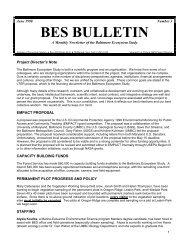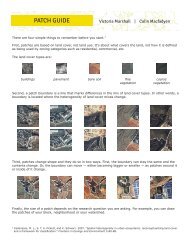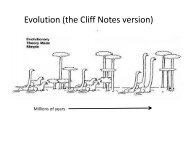Investigations in Urban Soils - Baltimore Ecosystem Study
Investigations in Urban Soils - Baltimore Ecosystem Study
Investigations in Urban Soils - Baltimore Ecosystem Study
You also want an ePaper? Increase the reach of your titles
YUMPU automatically turns print PDFs into web optimized ePapers that Google loves.
8. At this po<strong>in</strong>t, students should have completed at least a graph and a short<br />
conclusion. Students may enjoy the opportunity to present their f<strong>in</strong>d<strong>in</strong>gs <strong>in</strong> a<br />
simple presentation to the class. This can be the “Prelim<strong>in</strong>ary F<strong>in</strong>d<strong>in</strong>gs<br />
Symposium”.<br />
Part 3 - Us<strong>in</strong>g BES Data & Follow-Up<br />
Days 8 - 9: BES Data Comparison<br />
Students compare their f<strong>in</strong>d<strong>in</strong>gs to BES data on earthworm populations. They note<br />
measurements that BES scientists made and make plans for a modified <strong>in</strong>vestigation. (See<br />
Alternative Methods)<br />
Materials:<br />
Internet access to BES website www.beslter.org<br />
Optional: handout of BES data tables and graphs (BES Data from 2003, see<br />
Figure 16).<br />
Class data summary sheet and/or student-produced graphs from Day 7<br />
Preparation:<br />
1. Reserve computer time or LCD projector for students to view onl<strong>in</strong>e data.<br />
Preview current BES data with student data <strong>in</strong> hand to anticipate similarities and<br />
differences.<br />
Procedure:<br />
2. Generate a list of questions for reflection and/or discussion (see #1 below).<br />
3. Make sure all students have a copy of the class data <strong>in</strong> some form.<br />
1. Rem<strong>in</strong>d students that the purpose of compar<strong>in</strong>g their data to that of other<br />
scientists is to determ<strong>in</strong>e whether earthworm results <strong>in</strong> their community<br />
corroborate or negate the results from communities previously studied <strong>in</strong><br />
<strong>Baltimore</strong>. Keep<strong>in</strong>g that <strong>in</strong> m<strong>in</strong>d, as students spend time look<strong>in</strong>g at the graphs<br />
on-l<strong>in</strong>e, they may f<strong>in</strong>d more differences than similarities between their results and<br />
scientific results. Some questions to consider post<strong>in</strong>g for student reflection and<br />
discussion <strong>in</strong>clude:<br />
a. Read the <strong>in</strong>troduction sections of the earthworm pages on the website.<br />
Summarize the research goals of BES scientists who are study<strong>in</strong>g<br />
earthworms <strong>in</strong> <strong>Baltimore</strong>. How are their goals different from our goal <strong>in</strong><br />
do<strong>in</strong>g this <strong>in</strong>vestigation? Does our <strong>in</strong>vestigation help answer any of the<br />
scientists’ questions?<br />
b. Choose one earthworm graph or table from the BES website that <strong>in</strong>cludes<br />
data for habitat similar to the ones we <strong>in</strong>vestigated. Was the habitat with<br />
the most worms the same for each <strong>in</strong>vestigation?<br />
c. If not, what other factors might have contributed to the difference <strong>in</strong><br />
distribution of earthworms <strong>in</strong> each <strong>in</strong>vestigation site?<br />
Draft 2 - (9.28.04)<br />
<strong>Baltimore</strong> <strong>Ecosystem</strong> <strong>Study</strong> – <strong>Investigations</strong> <strong>in</strong> <strong>Urban</strong> <strong>Soils</strong><br />
page 33






